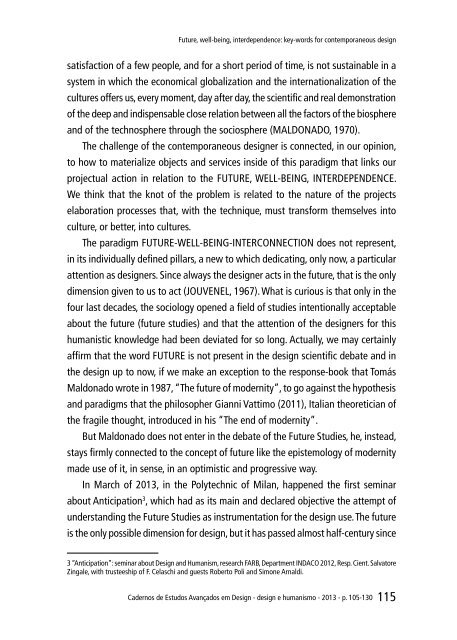o_19po8js951tvs1r0t1r8s4bb1vpla.pdf
You also want an ePaper? Increase the reach of your titles
YUMPU automatically turns print PDFs into web optimized ePapers that Google loves.
Future, well-being, interdependence: key-words for contemporaneous design<br />
satisfaction of a few people, and for a short period of time, is not sustainable in a<br />
system in which the economical globalization and the internationalization of the<br />
cultures offers us, every moment, day after day, the scientific and real demonstration<br />
of the deep and indispensable close relation between all the factors of the biosphere<br />
and of the technosphere through the sociosphere (MALDONADO, 1970).<br />
The challenge of the contemporaneous designer is connected, in our opinion,<br />
to how to materialize objects and services inside of this paradigm that links our<br />
projectual action in relation to the FUTURE, WELL-BEING, INTERDEPENDENCE.<br />
We think that the knot of the problem is related to the nature of the projects<br />
elaboration processes that, with the technique, must transform themselves into<br />
culture, or better, into cultures.<br />
The paradigm FUTURE-WELL-BEING-INTERCONNECTION does not represent,<br />
in its individually defined pillars, a new to which dedicating, only now, a particular<br />
attention as designers. Since always the designer acts in the future, that is the only<br />
dimension given to us to act (JOUVENEL, 1967). What is curious is that only in the<br />
four last decades, the sociology opened a field of studies intentionally acceptable<br />
about the future (future studies) and that the attention of the designers for this<br />
humanistic knowledge had been deviated for so long. Actually, we may certainly<br />
affirm that the word FUTURE is not present in the design scientific debate and in<br />
the design up to now, if we make an exception to the response-book that Tomás<br />
Maldonado wrote in 1987, “The future of modernity”, to go against the hypothesis<br />
and paradigms that the philosopher Gianni Vattimo (2011), Italian theoretician of<br />
the fragile thought, introduced in his “The end of modernity”.<br />
But Maldonado does not enter in the debate of the Future Studies, he, instead,<br />
stays firmly connected to the concept of future like the epistemology of modernity<br />
made use of it, in sense, in an optimistic and progressive way.<br />
In March of 2013, in the Polytechnic of Milan, happened the first seminar<br />
about Anticipation 3 , which had as its main and declared objective the attempt of<br />
understanding the Future Studies as instrumentation for the design use. The future<br />
is the only possible dimension for design, but it has passed almost half-century since<br />
3 “Anticipation”: seminar about Design and Humanism, research FARB, Department INDACO 2012, Resp. Cient. Salvatore<br />
Zingale, with trusteeship of F. Celaschi and guests Roberto Poli and Simone Arnaldi.<br />
Cadernos de Estudos Avançados em Design - design e humanismo - 2013 - p. 105-130<br />
115



